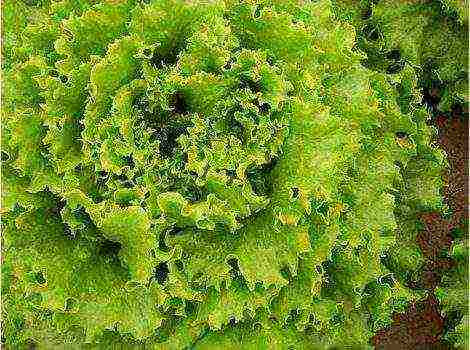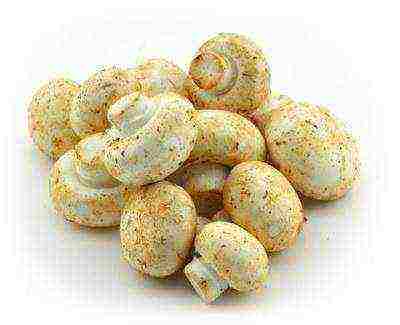Content
There are more than enough mushroom lovers in our country! Only for a hike in the forest for a "quiet hunt" you need the accompanying weather and certain climatic conditions. Not everyone will think about growing mushrooms at home, and even almost on an industrial scale. Most consider this to be fantastic. However, everything is real. And we will tell you how to grow mushrooms in a greenhouse or at home.
What mushrooms can be grown at home
The very idea of growing mushrooms at home poses a choice of a specific species. All varieties suitable for home breeding do not need special material costs or additional efforts. The only exceptions are champignons, but an experienced gardener will cope with this problem too. The choice must be made, first of all, based on the desired profit. All varieties of mushrooms suitable for growing at home can be classified into two main types:
- woody;
- soil.
The former include the well-known shiitake mushrooms, oyster mushrooms, and winter mushrooms. But to the second - no less popular mushrooms and ringlets. Even with small areas, the harvest can be excellent. That is why these varieties are recommended for growing on an industrial scale.
 Growing oyster mushrooms at home on the balcony
Growing oyster mushrooms at home on the balcony
Growing technology for beginners
The bulk of the time it takes to grow mushrooms is spent creating mycelium. However, the advice of experienced mushroom growers suggests that it is better to grow this material on your own. After all, even the best and trusted suppliers fail from time to time. Mycelium can be grown in two ways:
- in the grain substrate;
- on wooden sticks.
The choice depends on what kind of mushrooms you plan to grow.
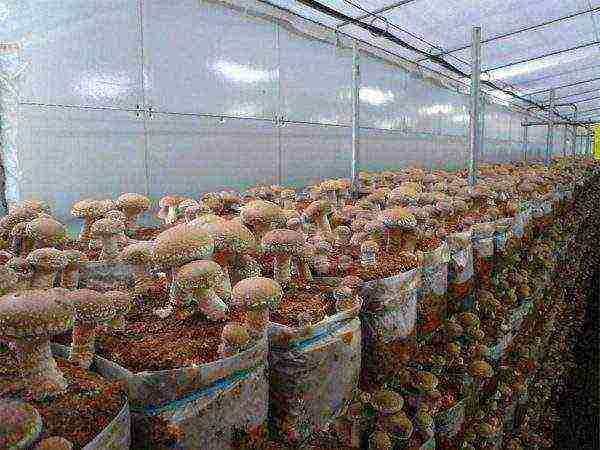 Growing mushrooms on a nutritious substrate
Growing mushrooms on a nutritious substrate
Breeding mycelium
The mycelium is grown in a specific substrate. It is recommended to make sure that its chemical and mineral composition is as similar as possible to that in which mushrooms grow naturally. The composition of this medium must be selected again, depending on the type of mushrooms being grown.
For example, shiitake mushrooms feel more comfortable in wood, mushrooms - in compost, but oyster mushrooms prefer straw. With proper care, chopped straw and sawdust can yield any of these types of mushrooms. However, the substrate must be of high quality. This is ensured by its dryness, absence of mold, as well as unpleasant odors and foreign impurities.
Wheat straw is best suited for growing mushrooms. You can also use rye or barley. Oyster mushrooms are allowed to be propagated in sunflower husks. However, only fresh material should be used, since pathogenic bacteria can grow excellently in old ones.
The mycelium is the backbone of a large number of germinated fungal spores. As soon as this base is placed in the substrate, the process of active growth begins. Initially, only the appearance of thin filaments can be observed, which eventually turn into edible mushrooms.
 Mushroom mycelium
Mushroom mycelium
It is worth purchasing high-quality planting material only in specialized stores.Priority should be given to wood containing viable fungal spores. They will be more resistant to disease. Not planted from grain mycelium. You can also buy common mushroom spores. Only in this case it will take more time and effort to grow your crop. The procedure will resemble the cultivation of any crop from seed. It is better for beginners to avoid this method.
To obtain the maximum yield, it is necessary that the mycelium spreads as thoroughly as possible in the compost. To do this, you need to keep the planting warm. They can be heated using a special electric pillow. Heat is needed only during the incubation period. Once the mushrooms are in the growing phase, it is best to keep them cool. A glazed and insulated balcony is well suited for this.
When growing mushrooms in residential premises, the maturation phase must be avoided. Otherwise, the spores released into the air can provoke allergic reactions and even asthma.
As a rule, seedlings appear in the third week after planting the mycelium. Readiness for harvesting is determined by the hat. You need to cut off ready-made mushrooms only with a knife, so as not to injure those that are still in the soil and are just preparing to give a crop. The ready-made collection can be used both immediately and after preliminary freezing.
 Sectional diagram of mushroom growth from mycelium
Sectional diagram of mushroom growth from mycelium
Other ways to grow mushrooms at home
In addition to the main ones, there are also additional ways of growing mushrooms. True, they do not bring such a large-scale result and are used mainly by children as experiments. For example, some types of mushrooms can be grown on logs. For this logs up to half a meter long are cut from hardwood. This must be done at least 2 weeks before settling with mycelium.
In the resulting blank, holes are made in a checkerboard pattern at a distance of 10 cm. After that, the sticks with mycelium must be sealed. A hammer can be used for this procedure.
Before starting work, you must disinfect your hands and make sure that there is no debris in the holes.
The logs filled with mycelium are placed in the basement and wait until it fills the entire space. The procedure is lengthy and can take up to 1 year. Temperature and humidity are considered key conditions.
A known method of growing mushrooms on coffee grounds. It contains many trace elements:
- manganese;
- potassium;
- magnesium;
- nitrogen.
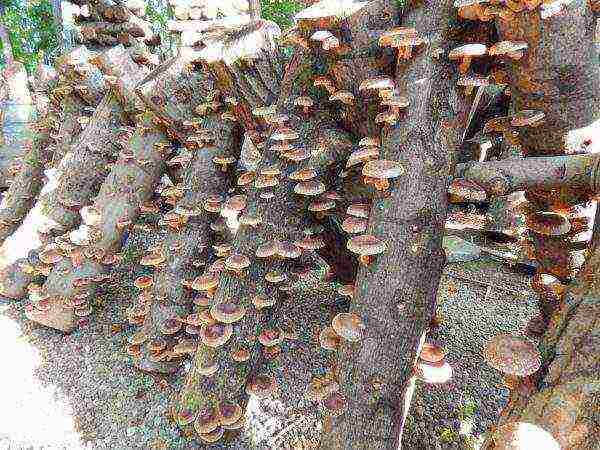 Growing mushrooms on stumps
Growing mushrooms on stumps
This environment is ideal for oyster mushrooms. In addition, the coffee grounds do not need to be sterilized again. The disadvantage of this method is that it is very difficult to get a large amount of freshly drunk cake at home. We'll have to ask him at the nearest cafe. The growing container can be regular freezer bags or ice cream containers.
The mycelium must be mixed with the cake, and then the container must be tightly closed. It can be stored under the sink. Germination time will be about 1 month. Once the surface is white, cut a small hole in the top of the bag. Through it, it is necessary to spray with water 2 times a day. After a week, you can see how small mushrooms begin to grow.
Growing porcini mushrooms and other species at home for beginners is a very exciting and useful activity. The needs of your family can be fully satisfied, even without special skills and large areas. The main thing is patience and a desire to see the result. After all, you can grow them all year round!
Home growing of mushrooms is becoming more and more popular every year. Unfortunately, not all varieties of mushrooms can be bred in this way, some of them are too capricious to the surrounding conditions, others require serious financial investments.Based on this, before you start mushroom growing on your own, you need to find out what mushrooms are grown at home. Most often these are the following types:
- Champignons (all varieties), volvariella, ringlet, raincoat, dung beetle. These are soil fungi, usually they grow in fields or meadows in the humus layer of the soil.
- Porcini mushrooms, chanterelles, boletus, boletus, truffles, morels, mushrooms. These are mycorrhizal fungi that form a symbiosis with the roots of only certain trees. They are artificially grown from purchased mycelium (mycelium is sprouted mushroom spores that are placed in a substrate), but it is rather difficult to breed these types at home.
- Oyster mushroom (all types - common, royal, pink, lemon), honey mushrooms (winter, summer, poplar, marble), gericium, tinder fungus, shiitake. These types of fungi grow on the wood of dead trees or plant debris containing cellulose.
The most unpretentious of all and the easiest to grow at home are oyster mushrooms, shiitake, winter mushrooms, mushrooms and ringlet.
All of these species have certain requirements for the conditions of detention. It remains only to figure out which ones.
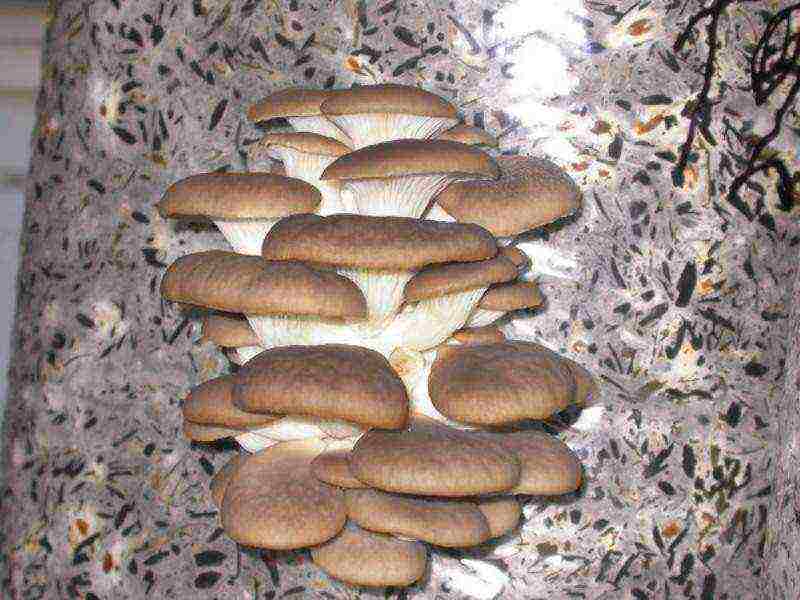 Oyster mushroom is in the first place in terms of prevalence and ease of cultivation. For novice mushroom growers, experienced entrepreneurs who have been engaged in mushroom growing for a long time suggest starting mushroom cultivation with it. When artificially growing oyster mushrooms, costs are required less than for all other mushrooms. Oyster mushroom is distinguished by unpretentiousness, excellent taste, early maturity, excellent yield, high resistance to viruses and bacteria, as well as rather long shelf life. Oyster mushrooms are grown in plastic bags (with a substrate, mushroom mycelium and bio-additives), on hemp, sawdust of various trees, straw, husk, corn stalks. Mushrooms grow well in rooms with a humidity of 80-85% and at fairly wide temperature ranges (from 10 to 30C, average values 16-20C). The first harvest of mushrooms can be cut after 30 days (in winter after 45). From one mushroom block at a time, it turns out to remove an average of 2.5-3 kg of crop. At the same time, serve 100 blocks on an area with an area of 30 sq. m. without any problems even one person can. Mushrooms produce crops for 5 years.
Oyster mushroom is in the first place in terms of prevalence and ease of cultivation. For novice mushroom growers, experienced entrepreneurs who have been engaged in mushroom growing for a long time suggest starting mushroom cultivation with it. When artificially growing oyster mushrooms, costs are required less than for all other mushrooms. Oyster mushroom is distinguished by unpretentiousness, excellent taste, early maturity, excellent yield, high resistance to viruses and bacteria, as well as rather long shelf life. Oyster mushrooms are grown in plastic bags (with a substrate, mushroom mycelium and bio-additives), on hemp, sawdust of various trees, straw, husk, corn stalks. Mushrooms grow well in rooms with a humidity of 80-85% and at fairly wide temperature ranges (from 10 to 30C, average values 16-20C). The first harvest of mushrooms can be cut after 30 days (in winter after 45). From one mushroom block at a time, it turns out to remove an average of 2.5-3 kg of crop. At the same time, serve 100 blocks on an area with an area of 30 sq. m. without any problems even one person can. Mushrooms produce crops for 5 years.- Champignon occupy the next place in terms of the popularity of cultivation, both in an industrial economy and at home. They are much more demanding on the conditions of detention. And the technology of growing them is more expensive than breeding oyster mushrooms. Mushrooms are grown in bags or boxes with soil in which the mycelium is laid. Champignons grow well in dark, cool rooms (12-18C, maximum value no more than 28C) with a humidity of 65-85%. The first harvest of mushrooms is ready for harvest in 45-50 days, and the next ones can be harvested within 3 months.
 Shiitake - not only tasty, but also a very healing mushroom (it is successfully used in the treatment of cancer). Until a certain moment, it was grown only in Asian countries. Shiitake is one of the most expensive mushrooms (the price is about $ 50 per 1 kg). Grows well at an average temperature of 12C. It is grown on sections of wood and on various substrates. It is important to know that in order to get a harvest of really tasty and healthy shiitake, the mycelium for breeding must be purchased from Japan or China, but not European, because it is spoiled by selection. The first harvest usually begins only in the next year and will last up to three years.
Shiitake - not only tasty, but also a very healing mushroom (it is successfully used in the treatment of cancer). Until a certain moment, it was grown only in Asian countries. Shiitake is one of the most expensive mushrooms (the price is about $ 50 per 1 kg). Grows well at an average temperature of 12C. It is grown on sections of wood and on various substrates. It is important to know that in order to get a harvest of really tasty and healthy shiitake, the mycelium for breeding must be purchased from Japan or China, but not European, because it is spoiled by selection. The first harvest usually begins only in the next year and will last up to three years.- Winter honey - mushroom quite resistant to cold, grows well at ambient temperatures of 1-2 ° C. This mushroom has a pleasant taste and good nutritional value. It perfectly adapts to parasitizing on trees with living wood, and for this reason it should not be grown in backyard gardens or vegetable gardens, it is recommended to grow only on substrates and log cabins indoors.
- Koltsevik - not very well-known mushroom. Its cultivation began relatively recently, only about 25 years ago. This mushroom outwardly resembles a boletus, and in taste competes with champignons.It is grown on a personal plot directly on open ground beds or in plastic bags and boxes.
By becoming familiar with which mushrooms are grown at home, choosing a certain type for yourself and following the rules of caring for them, you will receive a constant tasty source of nutrients.
A lot of people love mushrooms. There are those who like to eat them, there are those who enjoy collecting them (the so-called "mushroom pickers"). Taking into account the fact that the area of forests is decreasing, and cities are becoming more and more farther from green spaces, every year fewer people go out to "hunt" for mushrooms.
But mushroom lovers did not lose heart and came up with many ways to grow them at home. This requires attention, time and certain knowledge, which can be obtained by reading the following article.
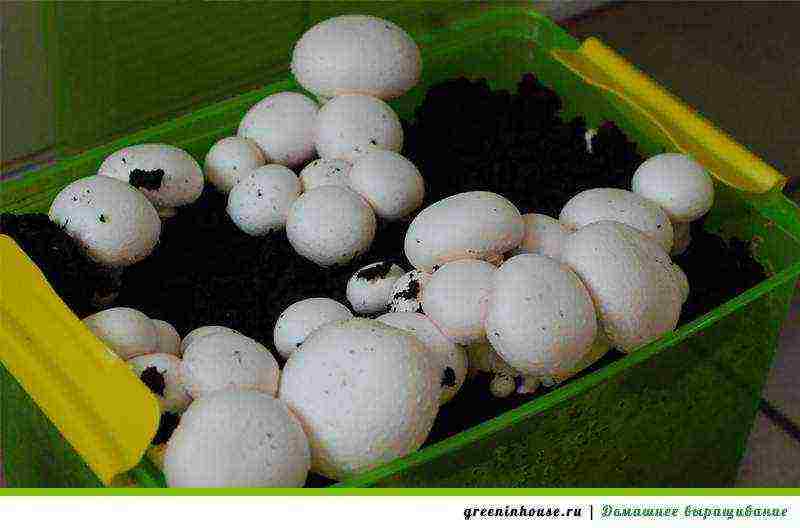
to the content ↑ What mushrooms can be grown at home
After assessing your capabilities, namely: the availability of sufficient area, sufficient opportunities to provide the required temperature, humidity and light, you can start growing mushrooms at home. The first step is to decide what species you want to see in your garden. The possibilities of the agricultural industry allow active amateur mushroom pickers to both grow mushrooms at home all year round, almost any species growing in the forest, and spend minimal effort on it.
What types of mushrooms can be grown at home? Let's figure it out. The simplest forest mushrooms are porcini, chanterelles, russula or boletus. Perfect for adding them to soups and hot dishes. Oyster mushrooms and mushrooms are very popular for salads and snacks. And even exotic species such as shiitaks, flammulines and ringlets. Usually, shitaki, champignons or oyster mushrooms are chosen for small home-made mushroom production, but other species can undoubtedly settle on your windowsill.
back to contents ↑ What is mycelium
It is better for beginner mushroom pickers to start growing a product from the mycelium. The mycelium itself is the root structure of any mushroom. Sold as sawdust or straw with mycelium. If we compare the methods of growing with the help of mycelium and spores, then growing in the first way is much easier and more efficient. They are on sale on the Internet, in industrial points with various organics, or in gardening shops. They provide a wide range of products.
back to contents ↑ How to prepare a nutrient medium for growing mushrooms
The nutrient medium (substrate) for planting myceliums may well look like ordinary sawdust, shavings, finely chopped straw or corn stumps. For greater soil mineralization, chicken manure is added when preparing compost, or stalks of grain crops (for example, corn) or leaves fallen from trees are used as organic fertilizers.
The substrate must be sterilized before planting myceliums into it. Don't forget this! Since if you omit this point, then microorganisms that can multiply with the mycelium can spoil it. As a result, the mushroom will grow bad or sick. To carry out a simple sterilization procedure, it is enough to put a bowl with a soaked nutrient medium (most often straw or sawdust) in a microwave oven for a short time and warm it up at a high frequency for 2 minutes. If the liquid has not boiled away during this time, you can extend the procedure.
back to content ↑ Planting mushrooms
In order for the mycelium to spread better in the nutrient medium, it must be heated before the germination of mushrooms, since heat stimulates all processes associated with the growth and development of organisms. Warm up the nutrient medium at a temperature of about 20 degrees. And then, to spread the mycelium, you need to put the container in a light-proof box or cabinet for 21 days.
After three weeks, transfer the container to a place with a temperature of about 13-15 degrees.This temperature can be reached in a room that is not heated. To prevent the soil from losing moisture, cover the container with a towel soaked in water, or carefully monitor the soil and spray it. It is ideal to grow mushrooms in the basement of the house, as the conditions are much better there.
back to content ↑ Alternative sources of cultivation
You can grow mushrooms not only in a standard and simple way for you. If the period of growing mushrooms at the “amateur” level has already ended for you, and you want to try something new, then you can choose how to grow mushrooms at home using alternative options. This can be either sprouting myceliums in coffee grounds, or using birch plugs (growing mushrooms on a tree or log), or in a fairly simple way - from a set. These are the most common options below.
back to content ↑ A fun way to grow mushrooms
Growing mushrooms from the kit is fun and easy to implement. It may seem even simpler than the standard version. The set is very easy to use, quite inexpensive ($ 20-30), sold in a large number of online stores and gardening outlets.
To start using it, you do not need to sterilize the substrate, since the plastic bag in which it is located is already filled with completely prepared soil. It is only necessary to contain an open package in mandatory conditions, and in less than 2 weeks you will be able to observe the mushrooms grown with your own hands on your windowsills. What mushrooms are grown at home in this way? Basically the most common varieties such as champignons, shitaki and oyster mushrooms.
The most important thing when growing mushrooms from a kit is to install it in a place with the right lighting. It should be bright, but not in direct sunlight. Also, do not forget to constantly moisturize the soil in the bag.
back to content ↑ Grow mushrooms from coffee grounds
In the active rhythm of city life, a large number of people start their morning with a cup of coffee. Now the used grounds will be useful to you too. After all, it is ideal for growing oyster mushrooms. Considering that the coffee was brewed at a high temperature, the grounds are completely sterilized and ready to be planted with mushrooms. The indisputable advantage of coffee grounds is the large amount of minerals and nutrients in it.
The coffee grounds are placed in a dense geotextile bag. It can be purchased along with myceliums at gardening stores. If there is no such bag, then a milk or ice cream bag is completely used, previously washed clean and with four holes made along the edges.
After placing the myceliums in the coffee grounds, the whole mass must be transferred to a bag. Conditions for the next 20 days are temperatures of about 20 degrees and darkness. After 20 days, the mycelium will completely settle in the thick and the contents of the bag will turn white. After that, you should place a bag or bag in a bright place with a shade for a week, making a small hole at the top and moistening it 2 times a day, so as not to let the soil dry out. Since mushrooms love moisture, and will not grow in too dry soil.
back to content ↑ Growing mushrooms on logs
Shiitaki mushroom, unusual for our area, is best grown on a log. This method consists in the fact that deciduous tree logs are plugged with birch corks. Before that, they are completely inoculated with mycelium. They can be ordered online or in specialized stores selling mushroom spores or myceliums.
One of the important factors for a successful harvest is a quality log. The most commonly used logs are maple, oak or poplar. All logs must be of a certain size. The diameter is not more than 35 centimeters, but 1 decimeter long.The preparation of a log does not require any special manipulations, you just need to cut it out 15 days before the mycelium is settled in it. During this period, its natural anti-fungal properties are completely destroyed.
A log of 10 centimeters will need about 5 dozen corks. They should not be located close to each other. Holes with a depth of 5 centimeters can be made with a drill, and finally closed with a hammer. The mycelium will spread throughout the log, and when it completely populates it, the fungi will start to sprout from the cracks into the log. This is a fairly long-term method of growing mushrooms, it takes from 9 to 12 months.
back to contents ↑ Care
The most important criteria for growing mushrooms are temperature, light and humidity. It is very difficult to monitor the maintenance of conditions at the desired level on your own, so it is worth purchasing sensors that can be found in any hardware store.
The temperature in the room in which the mushrooms grow should not exceed 24-25 degrees Celsius. If the temperature is higher. Then the mycelium will germinate poorly and, as a result, will be superficial. The moisture content of the soil should be at the level of 55-60%, because a very dry soil adversely affects the growth of fungi.
2 weeks after germination of the mushrooms, the temperature in the room should be reduced to 18 degrees, and the surface should be covered with earth. Further care consists in maintaining the temperature up to 20 degrees, and the air humidity up to 90%. In such conditions, the first mushrooms will sprout by the fortieth day, and will continue to germinate for another three months.
to the content ↑ Is it possible to grow mushrooms at home
You can read in more detail in the article technology for growing mushrooms at home... But only if carefully and carefully. The fact is that the conditions that are necessary for growing mushrooms (namely humidity and temperature) are such that it is difficult to maintain them at home. Another important factor is the release of spores into the air by ripe mushrooms. Unfortunately, spores are a strong allergen, therefore, with frequent and prolonged contact, they can cause respiratory diseases.
How to grow good mushrooms at home, without harm to health? The most important thing is to harvest on time and regularly. Experts say that the maximum release of spores occurs precisely at the time when the mushrooms are already overripe. It is also worth using a bandage when working indoors with mushrooms. Be sure to comply with sanitary standards when processing the walls of the room in which the seedlings are located with a solution of 1% bleach once a year. Only at a time when the mushrooms do not grow there, otherwise it will slow down the spread of the mycelium and, accordingly, stop the growth of the mushrooms. The easiest way, of course, is to move your small plantation to a basement or garage.
Similar articles:
- How to grow coffee at home
- How to grow strawberries at home
- How to plant basil at home
- The technology of growing mushrooms at home
Wild edible mushrooms are a seasonal product. But recently, even in spring and autumn, it has become difficult to collect them. Frequent natural anomalies, droughts, early frosts leave connoisseurs of this product without their favorite dishes.
However, craftsmen found a way out by learning how to grow some types of mushrooms at home. Today they are happy to share their experience.
In what conditions can mushrooms be grown
To get a good harvest, any kind of mushroom must create certain conditions. In-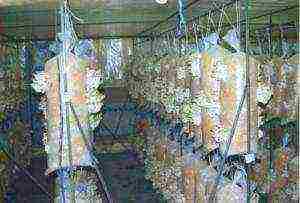 firstly, they need very high humidity, and secondly, during the fruiting period, the ambient temperature should be only 10-15 ° C. It is clear that this is impossible to achieve in an apartment. Of course, as a last resort, you can try to use the insulated balcony, but still, mushrooms will feel more comfortable in specially equipped sheds or basements.There they will be able to bear fruit up to 4 times a year.
firstly, they need very high humidity, and secondly, during the fruiting period, the ambient temperature should be only 10-15 ° C. It is clear that this is impossible to achieve in an apartment. Of course, as a last resort, you can try to use the insulated balcony, but still, mushrooms will feel more comfortable in specially equipped sheds or basements.There they will be able to bear fruit up to 4 times a year.
You can also grow mushrooms in your garden plots, but the result, as in the natural environment, will depend entirely on the weather. In addition, when planting myceliums in spring, you can get a crop only in autumn, and then under favorable weather conditions for growth.
A bit of terminology
A novice mushroom grower looking for useful information for himself suddenly comes across incomprehensible terms. What do they mean?
Mycelium - these are mycelium threads, roughly speaking, seeds, planting material.
Substrate - a specific mixture that provides mushrooms with the necessary nutrition for growth, development and fruiting. The substrate is usually placed in boxes or recesses in the ground, as well as on racks in specially equipped rooms.
The mycelium can be purchased at the store, but the substrate is made independently, and for each type of mushroom it has its own.
What types of mushrooms can be grown independently
Today, the range of online stores selling mycelium is surprisingly diverse. Believe it or not, you can grow more than 25 types of mushrooms at home! Although traditionally, the preference is given to champignons, oyster mushrooms, shiitake and porcini mushrooms. It is not surprising, these mushrooms are well known to everyone, have excellent taste, and are part of many dishes.
White mushroom. Agrotechnics
The substrate for growing porcini mushrooms can be prepared almost before planting the mycelium. For it, 5 liters of soil containing peat are mixed (you can use ready-made soil for indoor plants), 1 kg of wet sawdust of a coniferous tree, the same amount of fallen leaves. The mycelium is planted to a depth of 20 cm in prepared holes, the diameter of which is about 10 cm.The distance between these holes should be 30 cm.
Do not forget about regular moistening of the substrate, and then about a year after planting you can enjoy the first mushrooms, and in two years the yield will double. In general, such a mycelium can last up to 5 years.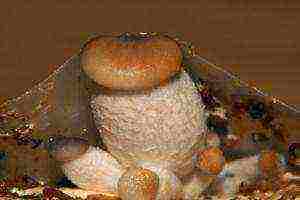
Champignon. Agrotechnics
Champignons are the most popular among mushroom growers. They are quite unpretentious and bear fruit perfectly even in the absence of any lighting. But the success of the cultivation is highly dependent on the correct preparation of the substrate. And it is prepared within a month on the basis of horse or cow manure and grain straw taken in equal proportions with the addition of mineral fertilizers: potassium superphosphate and ammonium nitrate.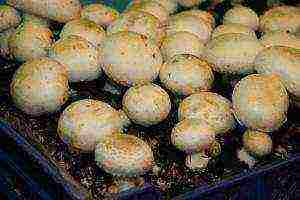
The finished substrate must be disinfected for three days. The composition of the disinfectant solution is extremely simple: 10 g of quicklime is added to 1 liter of water. After adding the solution, the substrate is stirred daily for 3 days. Then mycelium is evenly introduced into it.
As the substrate dries, it must be moistened with a spray bottle, and after a month, covered with plastic wrap with holes for air ventilation.
After complete overgrowth of the nutrient layer with mycelium, it is necessary to create a casing layer. To make it, 1 part of chalk powder is added to 9 parts of the finished raw soil for seedlings. This mixture is used to fill the substrate with mycelium by 2 cm. After a week, the cellophane film is removed. It is important to monitor thoroughly moistening the casing layer, and then the first fruits are formed in a month.
Oyster mushroom. Agrotechnics
Oyster mushroom is a high-yielding mushroom crop. Indoors, it bears fruit more often than once a month!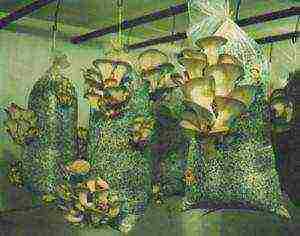
To grow oyster mushrooms, you need logs of medium diameter and about half a meter long with bark, but without branches and areas of rot. It is necessary to cut these logs from healthy hardwood trees one month before working with them. In a checkerboard pattern, at intervals of 20 cm, holes about 5 cm deep are drilled in the wood, where the planting material is placed.After that, the holes are covered with sawdust, and the log is buried by one third into the ground. Watering can be carried out both on the ground and on the wood itself 2 times a week. In a maximum of six months, the first mushrooms will begin to appear. When keeping wood outdoors for the winter, it must be insulated by sprinkling with fallen leaves.
In addition, oyster mushrooms can be grown in a substrate from various plant waste, such as sawdust of deciduous trees, husk of sunflower and cereal crops, corn silk and crushed cobs, and so on.
Shiitake. Agrotechnics
Shiitake is a crop successfully cultivated all over the world. For its cultivation, wood is needed, prepared in the same way as for oyster mushrooms. The only difference is that the logs must be 2 times longer. There are also some other points of difference in agricultural technology, namely, 3 months after the mycelium is populated into the wood, one side of the log must be placed in water for 12 hours. After that, the log is installed at an angle in a well-lit place, and after two weeks, the rudiments of the mushrooms will already be visible.
At first glance, the process of growing mushrooms on your own may seem quite laborious, but this is not entirely true. If you specialize in the cultivation of one or two types of mushrooms, experience is gained quickly enough, and the yields become invariably high.

